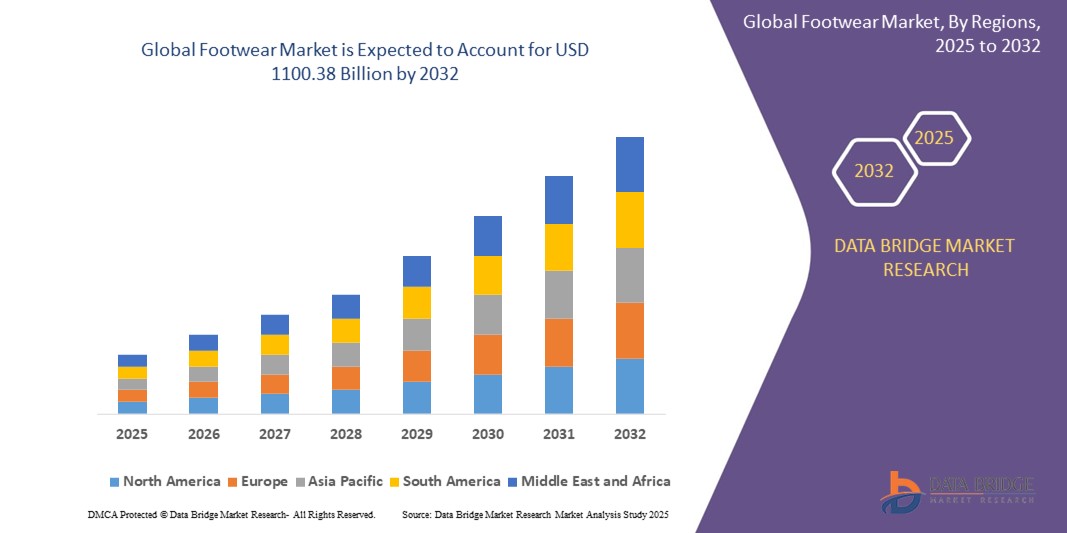Global Footwear Market
市场规模(十亿美元)
CAGR :
% 
 USD
700.90 Billion
USD
1,100.38 Billion
2024
2032
USD
700.90 Billion
USD
1,100.38 Billion
2024
2032
| 2025 –2032 | |
| USD 700.90 Billion | |
| USD 1,100.38 Billion | |
|
|
|
|
全球鞋類市場細分,按類型(休閒鞋、皮鞋、涼鞋/人字拖鞋、芭蕾舞鞋、靴子、坡跟鞋、運動鞋、保健鞋等)、鞋材/鞋底材料(塑膠、皮革、橡膠、紡織品等)、分銷通路(電子商務、專賣店、超市-大賣場、便利商店等)、最終用戶(女性、男性及兒童)
鞋類市場規模
- 2024 年全球鞋類市場規模為7,009 億美元 ,預計 到 2032 年將達到 11,003.8 億美元,預測期內 複合年增長率為 5.80%。
- 這個市場成長主要受到時尚意識的增強、生活方式偏好的改變以及全球人口的成長(特別是在可支配收入不斷增加的城市地區)的推動
- 此外,電子商務滲透率的飆升、運動休閒趨勢的不斷擴大以及消費者對定制和可持續鞋類的偏好,都是行業擴張的主要催化劑
鞋類市場分析
- 鞋類,包括休閒鞋、運動鞋、正裝鞋和專業鞋,已成為全球人口自我表達、功能性和生活方式協調的關鍵要素,材料、舒適度和設計的創新發揮關鍵作用
- 對環保材料、矯形支撐和高性能運動鞋的需求不斷增長,推動品牌採用先進的製造技術和數位客製化工具
- 男裝、女裝和童裝市場需求強勁,品牌知名度的提高、名人代言和合作限量版的推出進一步推動了成長,尤其是在城市和數位互聯地區
- 2024 年,北美佔據全球鞋類市場的主導地位,收入份額為 27.12%,這得益於強大的品牌影響力、運動和休閒鞋的創新以及對健康、健身和時尚趨勢的日益關注
- 亞太地區是全球成長最快的鞋類市場,預計 2025 年至 2032 年的複合年增長率將達到 5.11%。受城鎮化、可支配收入增加和數位零售擴張的推動,中國、印度和日本等主要市場的需求正在增長。
- 受健康意識增強、體育健身活動參與度增加以及運動休閒趨勢不斷擴大的推動,運動細分市場在 2024 年佔據市場主導地位,收入份額最高,為 28.9%。
報告範圍和鞋類市場細分
|
屬性 |
鞋類關鍵市場洞察 |
|
涵蓋的領域 |
|
|
覆蓋國家 |
北美洲
歐洲
亞太
中東和非洲
南美洲
|
|
主要市場參與者 |
|
|
市場機會 |
|
|
加值資料資訊集 |
除了對市場價值、成長率、細分、地理覆蓋範圍和主要參與者等市場情景的洞察之外,Data Bridge Market Research 策劃的市場報告還包括深入的專家分析、定價分析、品牌份額分析、消費者調查、人口統計分析、供應鏈分析、價值鏈分析、原材料/消耗品概述、供應商選擇標準、PESTLE 分析、波特分析和監管框架。 |
鞋類市場趨勢
“永續性和生態創新推動產品開發”
- 全球鞋類市場日益增長且變革性的趨勢是注重永續材料和環保的生產流程。消費者,尤其是千禧世代和Z世代,要求產品符合道德規範且環保,這推動品牌走向更綠色的創新。
- 領先的鞋類公司正在推出由再生塑膠、植物性材料和可生物降解零件製成的產品。例如,阿迪達斯推出了一款100%可回收的高性能跑鞋“Futurecraft Loop”,而Allbirds則在其係列產品中使用了美利奴羊毛和甘蔗等天然材料。
- 企業也採用循環經濟模式,鼓勵消費者退回舊鞋進行回收或轉售。耐吉的「Move to Zero」計畫就是一個值得注意的例子,旨在減少其整個產品線的碳排放和浪費。
- 3D 針織和積層製造等先進生產技術正在減少生產過程中的材料浪費,同時實現客製化、按需製造,最大程度地減少對環境的影響
- 隨著環境議題成為核心購買因素,永續性不再是一種小眾價值,而是影響產品設計、行銷和供應鏈實踐的主流需求
- 消費者環保意識的增強和政府對永續發展的監管預計將加速整個鞋類產業的材料科學和廢物減少的創新
鞋類市場動態
司機
“運動休閒和功能性時尚的需求日益增長”
- 運動休閒風潮在全球範圍內興起,運動服飾融入休閒和日常時尚,成為鞋類市場的重要推動力,尤其是在運動和生活方式類別
- 消費者越來越青睞舒適、時尚、百搭的鞋履,無論是在健身房或街頭,都能輕鬆駕馭,刺激了運動鞋、訓練鞋和便鞋的需求。這一趨勢在城市青年和職場人士中尤為明顯。
- 2024年3月,彪馬公佈其生活鞋類銷售額實現兩位數成長,這得益於針對運動休閒細分市場的新品系列。同樣,Lululemon和Under Armour也繼續拓展其鞋類產品線,以補充其運動服飾系列。
- 疫情加速了這一轉變,遠距辦公和休閒服裝規範推動了對功能性休閒鞋的需求。如今,消費者尋求兼具功能性、時尚感和舒適度的鞋款。
- 運動品牌與時尚影響者之間的合作日益增加(例如 Nike x Travis Scott 或 Adidas x Gucci),進一步增強了運動休閒鞋的吸引力,並擴大了其在不同人群和地區的影響力
克制/挑戰
“供應鏈中斷和原材料波動”
- 鞋類產業繼續面臨與全球供應鏈中斷相關的挑戰,特別是在採購材料和有效管理國際物流方面
- 原材料短缺(例如橡膠、皮革、合成纖維)、運輸延誤以及運輸成本上升嚴重影響了全球鞋類品牌的生產時間表和成本結構
- 2023 年末,VF Corporation(Vans 和 Timberland 的母公司)報告獲利低於預期,原因是東南亞製造中心的交貨時間延長和運輸積壓
- 地緣政治緊張局勢、更嚴格的環境法規以及流行病或氣候引發的災害等意外事件可能會加劇這些挑戰,擾亂基本部件的持續供應
- 各大品牌正試圖透過多元化供應商、將部分製造業務回流以及投資智慧物流和庫存管理系統來緩解這個問題。然而,此類轉型需要高昂的資本成本和時間成本。
- 尤其是對於中小型公司而言,在供應鏈持續不穩定的情況下,控製成本膨脹和保持及時的產品交付仍然是擴大規模和盈利能力的重大障礙
鞋類市場範圍
市場根據類型、鞋材/鞋底材料、分銷管道和最終用戶進行細分。
- 按類型
根據鞋類類型,鞋類市場細分為樂福鞋、皮鞋、涼鞋/人字拖、芭蕾舞鞋、靴子、坡跟鞋、運動鞋、保健鞋和其他。運動鞋領域佔據市場主導地位,2024 年收入份額最高,達到 28.9%,這得益於人們日益增強的健康意識、運動和健身活動參與度的提高以及運動休閒風的不斷興起。運動鞋憑藉其多功能性、舒適性以及不斷演變的設計,無論休閒或運動,都能夠完美契合,因此在各個人群中持續受到廣泛歡迎。
預計靴子行業將在 2025 年至 2032 年間見證最快的複合年增長率,這得益於寒冷地區的需求不斷增長、職業環境中靴子的使用日益增多以及男女類別的時尚趨勢不斷發展。
- 按鞋材/鞋底材質
根據鞋材/鞋底材料,市場細分為塑膠、皮革、橡膠、紡織品和其他。橡膠憑藉其耐用性、防水性、柔韌性和成本效益,在2024年佔據了最大的市場份額,達到32.4%,使其成為運動、工作和休閒鞋的首選材料。橡膠鞋底因其減震性能和適應各種地形而尤其受歡迎。
預計紡織業將在 2025 年至 2032 年間實現最快增長,這得益於可持續面料的創新、輕量化設計以及消費者對透氣和環保材料的日益增長的偏好。
- 按分銷管道
根據分銷管道,市場細分為電商、專賣店、超市/大賣場、便利商店和其他。電商佔據市場主導地位,2024 年收入份額最高,達到 38.7%,這得益於日益增長的在線購物行為、極具競爭力的價格、更廣泛的產品種類以及便捷的產品比較。直銷品牌 (DTC) 和線上獨家產品的興起進一步推動了這個細分市場的發展。
預計專賣店領域將在 2025 年至 2032 年間實現最快的複合年增長率,這得益於個性化服務、獨家品牌體驗以及購買前的實體試用——這在鞋類行業尤為重要。
- 按最終用戶
根據終端用戶,市場分為女鞋、男鞋和童鞋。 2024年,女鞋市場佔據了42.5%的主導收入份額,這得益於女性消費者人均鞋類擁有量的提高、對時尚多樣性的重視以及購買力的提升。各大品牌持續推出針對女鞋市場的多樣化產品系列和季節性系列,進一步推動了市場成長。
預計兒童領域將在 2025 年至 2032 年間經歷最快的複合年增長率,這主要得益於發展中經濟體出生率的上升、人們對足部護理的認識的提高以及由於快速生長而產生的頻繁更換需求。
鞋類市場區域分析
- 2024 年,北美佔據全球鞋類市場的主導地位,收入份額為 27.12%,這得益於強大的品牌影響力、運動和休閒鞋的創新以及對健康、健身和時尚趨勢的日益關注
- 該地區的消費者越來越被環保材料、客製化功能和數位購物體驗(例如虛擬試穿和人工智慧驅動的尺寸)所吸引
- 高可支配收入、運動參與度以及運動休閒服的流行繼續推動對高端和高性能鞋類的需求
美國鞋類市場洞察
2024年,受時尚潮流、健康意識提升以及強大的數位零售生態系統的推動,美國佔據了北美鞋類市場的主導地位。受運動鞋文化的興起以及與運動員和網紅的合作的推動,市場對高性能鞋類和限量版運動鞋的需求激增。具有環保意識的消費者也在推動品牌採用永續材料和符合道德標準的生產方式。耐吉、新百倫和卡駱馳等公司的創新正在提升消費者的參與度,而全通路策略和行動購物應用程式正在重塑消費者瀏覽和購買鞋類的方式。
歐洲鞋類市場洞察
歐洲鞋類市場正在穩步擴張,這得益於其眼光獨到、注重品質、風格和永續性的消費者群體。長期以來,該地區一直是全球時尚品牌和傳統品牌的發源地,尤其是在義大利、法國和德國,這些品牌持續影響著全球潮流。消費者越來越青睞環保且符合道德標準的鞋類,而奢侈品和設計師品牌則因品牌忠誠度高而蓬勃發展。電子商務的普及率正在上升,但實體零售對於高端消費仍然至關重要。零售概念的革新以及消費者對多功能舒適鞋類的需求,正在重塑高端市場和大眾市場的鞋類產品。
英國鞋類市場洞察
英國鞋類市場預計將保持健康成長,這得益於消費者對時尚、舒適和永續鞋履的強勁需求。隨著消費者對時尚的關注度和數位化程度的提升,線上零售通路日益受到重視,尤其是在Z世代和千禧世代群體中。符合道德和純素理念的鞋履日益流行,反映出英國民眾的價值觀正朝著永續發展的方向轉變。英國強大的物流和電商基礎設施使本地和全球品牌能夠有效率地觸及多元化的消費群體。此外,街頭潮流、運動時尚和運動鞋轉售文化的影響力也推動了不同價位的鞋履市場蓬勃發展。
德國鞋類市場洞察
德國鞋類市場蓬勃發展,阿迪達斯和彪馬等全球巨頭持續投資於創新、永續性和性能驅動型產品,為德國鞋類市場奠定了堅實的基礎。德國消費者註重舒適性、耐用性和環保責任,因此環保材料和功能性設計日益受到重視。矯正鞋和人體工學鞋的需求不斷增長,尤其是在老年人群中,也推動了德國鞋類市場的發展。德國先進的製造業生態系統和強大的零售業務支撐著涵蓋運動、休閒和商務類別的廣泛產品線。線上和線下體驗正在不斷優化,以更好地反映消費者對混合購物和詳細產品透明度的偏好。
亞太鞋類市場洞察
亞太地區是全球成長最快的鞋類市場,預計2025年至2032年的複合年增長率將達到5.11%。受城鎮化、可支配收入增加和數位零售擴張的推動,中國、印度和日本等主要市場的需求正在增長。亞太地區的消費者正在擁抱全球潮流和本土時尚的融合,形成了多樣化且快速發展的偏好。電商平台、社群媒體行銷和直銷品牌 (DTC) 正在重塑競爭格局。本地生產能力、經濟高效的供應鏈以及對智慧和永續鞋類日益增長的興趣,將繼續加速市場發展勢頭。
日本鞋類市場洞察
日本鞋類市場正穩步成長,這得益於該國科技創新、極簡時尚理念和人口老化等因素的共同作用。消費者重視舒適性、工藝和功能性,因此防滑、矯形和耐用型鞋履市場需求強勁。日本對高科技解決方案的青睞也延伸到了零售領域,虛擬試穿和行動購物日益普及。本土和國際品牌競相滿足消費者對時尚實用鞋履的需求,尤其是在城市中心地區。此外,日本日益增長的智慧家庭和互聯生活方式也透過注重便利性和性能間接影響鞋履設計。
中國鞋類市場洞察
2024年,中國在收入方面領先亞太鞋類市場,這得益於快速的城市化進程、高智慧型手機普及率以及數位化中產階級的崛起。中國消費者對時尚潮流的反應極高,運動鞋、奢華鞋履和運動休閒鞋履的需求尤其旺盛。電商巨頭和天貓、京東和抖音等社群平台在產品發現和銷售中發揮著至關重要的作用。本土製造能力使其能夠快速週轉,本土品牌在品質和創新方面與全球品牌的競爭日益激烈。政府的智慧城市計劃和對零售科技的投資進一步支撐了成長。
鞋類市佔率
鞋類產業主要由知名公司主導,其中包括:
- Crocs Retail, LLC(美國)
- 阿迪達斯(德國)
- SKECHERS USA, Inc.(美國)
- 耐吉公司(美國)
- 岡橋(美國)
- BATA品牌(瑞士)
- GEOX SpA(義大利)
- 彪馬(德國)
- Under Armour, Inc.(美國)
- Wolverine World Wide, Inc.(美國)
- ASICS株式會社(日本)
- ALDO 集團公司(加拿大)
- Relaxo Footwears Limited(印度)
- 開雲集團(法國)
- VF公司(美國)
- Deichmann SE(德國)
- FILA控股公司(韓國)
- 新百倫(美國)
- ECCO Sko A/S(丹麥)
- 巴寶莉(英國)
全球鞋類市場最新發展
- 2024年11月,法國運動生活風格品牌Salomon在倫敦及英國各地開設了兩家新的零售店,為健行和跑步愛好者提供豐富的高性能鞋履選擇。此次策略擴張彰顯了品牌持續致力於鞏固其在高端戶外鞋履領域的影響力。
- 2024年11月,總部位於美國的鞋類公司Crocs在印度喀拉拉邦的Lulu Mall開設了一家1,600平方英尺的新店,主打其標誌性系列和當季系列。此次開業凸顯了Crocs對印度零售市場和消費者群體的日益關注。
- 2024年7月,美國領先的鞋類製造商耐吉公司推出了其最新創新產品-Air Max Dn,旨在提供卓越的舒適度和現代美感。這款產品的發布標誌著耐吉持續致力於以性能為導向、兼具時尚感的設計,以吸引更廣泛的受眾群體。
- 2024年3月,總部位於印度的直銷鞋類品牌Yoho推出了最新運動鞋系列Blinc,該系列提供多種顏色,男女款均可透過其官網和領先的電商平台購買。此次發布體現了Yoho致力於透過多樣化的產品選擇吸引註重時尚的年輕消費者。
- 2023年11月,英國鞋類公司FitFlop推出了一項名為「For People Who Move」(為運動人士)的全新推廣活動,旨在提升其符合人體工學且時尚前衛的產品系列的知名度。這項活動強調了FitFlop作為支持積極生活方式並帶來時尚舒適體驗的品牌的定位。
SKU-
Get online access to the report on the World's First Market Intelligence Cloud
- Interactive Data Analysis Dashboard
- Company Analysis Dashboard for high growth potential opportunities
- Research Analyst Access for customization & queries
- Competitor Analysis with Interactive dashboard
- Latest News, Updates & Trend analysis
- Harness the Power of Benchmark Analysis for Comprehensive Competitor Tracking
研究方法
数据收集和基准年分析是使用具有大样本量的数据收集模块完成的。该阶段包括通过各种来源和策略获取市场信息或相关数据。它包括提前检查和规划从过去获得的所有数据。它同样包括检查不同信息源中出现的信息不一致。使用市场统计和连贯模型分析和估计市场数据。此外,市场份额分析和关键趋势分析是市场报告中的主要成功因素。要了解更多信息,请请求分析师致电或下拉您的询问。
DBMR 研究团队使用的关键研究方法是数据三角测量,其中包括数据挖掘、数据变量对市场影响的分析和主要(行业专家)验证。数据模型包括供应商定位网格、市场时间线分析、市场概览和指南、公司定位网格、专利分析、定价分析、公司市场份额分析、测量标准、全球与区域和供应商份额分析。要了解有关研究方法的更多信息,请向我们的行业专家咨询。
可定制
Data Bridge Market Research 是高级形成性研究领域的领导者。我们为向现有和新客户提供符合其目标的数据和分析而感到自豪。报告可定制,包括目标品牌的价格趋势分析、了解其他国家的市场(索取国家列表)、临床试验结果数据、文献综述、翻新市场和产品基础分析。目标竞争对手的市场分析可以从基于技术的分析到市场组合策略进行分析。我们可以按照您所需的格式和数据样式添加您需要的任意数量的竞争对手数据。我们的分析师团队还可以为您提供原始 Excel 文件数据透视表(事实手册)中的数据,或者可以帮助您根据报告中的数据集创建演示文稿。














